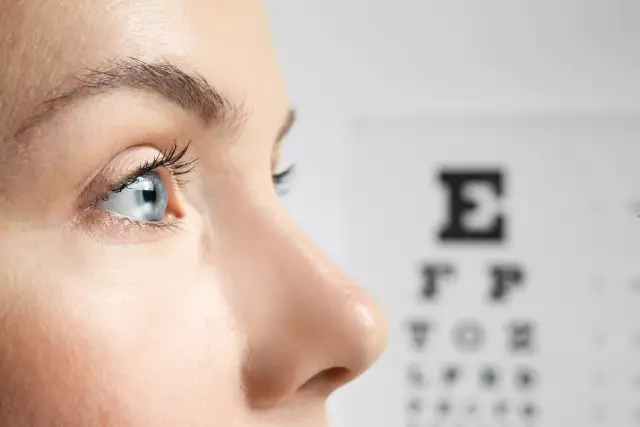- Author Rachel Wainwright [email protected].
- Public 2023-12-15 07:39.
- Last modified 2025-11-02 20:14.
How to preserve the eyesight of a student: 7 simple tips
From the moment a child becomes a schoolboy, his vision begins to undergo increased stress, which is complemented by watching cartoons and protracted computer games. During this period of life, the development of not yet fully formed organs of vision is very easy to disrupt, especially if there is no work and rest regime. As a rule, this is what happens: according to statistics from the World Health Organization, every fourth child of school age has some kind of eye disease, among which myopia is the most common. According to doctors, vision problems only in some cases are hereditary in nature - most children suffer through the fault of their parents, who have not built the daily routine.
To keep the student's vision sharp, to reduce the risk of eye diseases, ophthalmologists advise taking into account several basic rules.
Do not send to school earlier than 7 years
Experts do not recommend exposing children to school stress before the ciliary muscle of the eyes, which is responsible for the ability to see objects at different distances, is formed. Its development, as a rule, ends by 7-8 years, and before this age it is not worth testing it for strength. Indeed, according to statistics, among children who became first graders at the age of 6, there are twice as many myopic ones as among schoolchildren who went to the first grade at 7 or 8 years old.

Source: depositphotos.com
Limit visual stress
In the absence of vision problems, the child should take a break from classes every 40 minutes, and in case of myopia - every half hour. During the 10-15 minute rest, do not watch TV, read, play on the computer or engage in other activities related to eye strain. Better to play outdoor games.
The duration of home lessons for children of primary grades should not exceed 1 hour, for middle grades - 2 hours. If the child is attending additional classes, it is worth remembering that they should not last more than 1.5 hours on school days and 3 hours on weekends. In this case, electives should not begin earlier than 8.00 and end later than 20.00.
To strengthen the immune system, it is advisable for the child to be outdoors every day, playing outdoor games or playing sports, but traumatic sports should be avoided. Head bruises of varying severity can cause myopia or worsen it if it already exists.

Source: depositphotos.com
Set a computer work schedule
Computer games are a favorite pastime of modern children. If you do not control such leisure, computer visual syndrome may occur: a disorder that manifests itself in dryness, redness of the eyes, frequent blinking, difficulties in focusing vision at different distances, etc. Prolonged eye strain, including due to light pulsation of the screen, often becomes the basis for the development of accommodation spasm or lengthening of the eyeball and, as a result, myopia.
To prevent eye fatigue and related diseases, the child must comply with the norms of continuous work at the computer (SanPiN):
- for lower grades - 15 minutes;
- for middle classes - 25 minutes;
- for seniors - 40 minutes.
The "insidiousness" of the computer lies in the fact that, being carried away by the game, children do not notice fatigue, although it has been established that the first symptoms of visual fatigue (absent-mindedness, a decrease in the frequency of blinking) appear after 15 minutes of work, and after 25-30 minutes, certain signs of impairment vision can already be recorded by a specialist.
Parents who are concerned about the health of their child should not allow him to play on the computer in total for more than 1 hour a day; if possible, they should distract the student with other activities.

Source: depositphotos.com
Organize a student's workplace
The correct organization of the workplace will slightly reduce the burden on vision:
- the child's line of sight should be in the middle or upper half of the screen;
- the optimal distance to the computer monitor is 60-80 cm. It is better to choose a monitor with a high resolution to reduce the effect of screen flickering;
- light and direct sunlight should not fall on the monitor;
- you cannot work at a computer in the dark or twilight. It is better if the light source is on the left of the child.
The student's workplace should be well lit. In addition to natural lighting, the room needs artificial light sources - the main (chandelier) and additional (40-60 W table lamp). It is better to place a table lamp for a right-handed child on the left, for a left-handed person, on the contrary, on the right. At the same time, it is important to correctly combine lighting sources: in the dark, it is unacceptable to study only with the light of a chandelier or lamp, and during the day it is advisable to turn on only the lamp.
The optimal distance to the eyes when reading and writing is at least 35-40 cm, which must be taken into account when choosing a desk for a child. In addition, while working, he should not slouch, so the chair should not be too high and soft.

Source: depositphotos.com
Enrich your diet with vitamins
It's no secret that a strong, hardy organism is less susceptible to diseases, including eye diseases. A diet rich in vitamins and trace elements will provide optimal conditions for the retina and support vision. The most useful for these purposes are cottage cheese, kefir, beef, rabbit meat, foods high in vitamin A (carrots, apricots, pumpkin, citrus fruits), boiled fish, as well as berries (blueberries, cranberries, lingonberries) and herbs (dill, parsley) …

Source: depositphotos.com
Exercise your eyes
In between classes, it is advisable not only to relax, but to perform a few simple exercises for the eyes. Gymnastics will prevent the onset of myopia, and in nearsighted children - prevent its further development. 5-minute exercise improves circulation by relaxing the oculomotor muscles and relieving eye fatigue. Gymnastics is as follows:
- close your eyes for 2-3 seconds, then open for the same time. Repeat 5-7 times;
- turn your eyes alternately to the left and right. In this case, the head must remain motionless;
- put your finger at a distance of 30-35 cm from the eyes. Look at its tip. Lower your hand. Repeat 3-5 times;
- closing your eyes, massage the eyelids. Above - from the nose to the outer edge of the eye, below - vice versa.
It is important that the exercises are done with pleasure and without stress. Then daily exercise will be an excellent prevention of vision problems in a student.

Source: depositphotos.com
Take care of your baby's healthy sleep
Sometimes eye fatigue occurs due to a lack of sleep at night, the child simply does not have time to rest and recover. It is important that the student does not go to bed after 22.00 and does not get up before 7.00. In some cases, the lack of sleep at night can be compensated for by resting after school.

Source: depositphotos.com
To prevent eye fatigue from entering the child's life along with lengthy lessons and computer games, parents should organize his daily routine, alternating between sleep and wakefulness, outdoor play and lessons, sports and passive rest. If you correctly plan the day, filling it with interesting leisure activities, the student will not have vision problems.
YouTube video related to the article:

Maria Kulkes Medical journalist About the author
Education: First Moscow State Medical University named after I. M. Sechenov, specialty "General Medicine".
Found a mistake in the text? Select it and press Ctrl + Enter.






